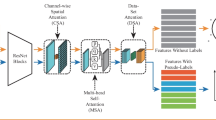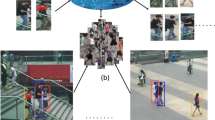Abstract
In recent years, person re-identification based on video has become a hot topic in the field of person re-identification. The self-attention mechanism can improve the ability of deep neural networks in computer vision tasks such as image classification, image segmentation and natural language processing tasks. In order to verify whether the self-attention can improve the performance or not in person re-identification tasks, this paper applies two self-attention mechanisms, non-local attention and recurrent criss-cross attention to person re-identification model, and experiments are conducted on Market-1501, DukeMTMC-reID and MSMT17 person re-identification datasets. The results show that the self-attention mechanism can improve the accuracy of the person re-identification model. The accuracy is higher when the self-attention module is inserted into the convolutional layers of the re-identification network.










Similar content being viewed by others
References
Bazzani L, Cristani M, Perina A, Farenzena M, Murino V (2010) Multiple-shot person re-identification by hpe signature. In: 2010 20th International conference on pattern recognition. IEEE, pp 1413–1416
Farenzena M, Bazzani L, Perina A, Murino V, Cristani M (2010) Person re-identification by symmetry-driven accumulation of local features. In: 2010 IEEE computer society conference on computer vision and pattern recognition. IEEE, pp 2360–2367
Gheissari N, Sebastian TB, Hartley R (2006) Person reidentification using spatiotemporal appearance. In: 2006 IEEE Computer society conference on computer vision and pattern recognition (CVPR’06), vol 2. IEEE, pp 1528–1535
Goodfellow I, Pouget-Abadie J, Mirza M, Xu B, Warde-Farley D, Ozair S, Courville A, Bengio Y (2014) Generative adversarial nets. In: Advances in neural information processing systems, pp 2672–2680
Hao L, Wei J, et al. (2019) A survey on deep learning based person re-identification. ACTA AUTOMATICA SINICA 45 (11):2032–2049. https://doi.org/10.16383/j.aas.c180154
He K, Zhang X, Ren S, Sun J (2016) Deep residual learning for image recognition. In: Proceedings of the IEEE conference on computer vision and pattern recognition, pp 770–778
Huang T, Russell S (1997) Object identification in a Bayesian context. In: IJCAI, vol 97, pp 1276–1282
Huang Z, Wang X, Huang L, Huang C, Wei Y, Liu W (2019) Ccnet: criss-cross attention for semantic segmentation. In: Proceedings of the IEEE international conference on computer vision, pp 603–612
Jian-Wei L, Hui-Dan Z, Xiong-Lin L, Jun X (2020) Research progress on batch normalization of deep learning and its related algorithms. Acta Automatica Sinica 46(6):1090–1120
Kingma DP, Ba J (2014) Adam: a method for stochastic optimization. arXiv:1412.6980
Krizhevsky A, Sutskever I, Hinton GE (2012) Imagenet classification with deep convolutional neural networks. In: Advances in neural information processing systems, pp 1097–1105
Li W, Zhao R, Xiao T, Wang X (2014) Deepreid: deep filter pairing neural network for person re-identification. In: Proceedings of the IEEE conference on computer vision and pattern recognition, pp 152–159
Li W, Zhu X, Gong S (2018) Harmonious attention network for person re-identification. In: Proceedings of the IEEE conference on computer vision and pattern recognition, pp 2285–2294
Paszke A, Gross S, Chintala S et al (2017) Automatic differentiation in pytorch
Qin L, Yu N, Zhao D (2018) Applying the convolutional neural network deep learning technology to behavioural recognition in intelligent video. Tehnicki Vjesnik 25:528–535. https://doi.org/10.17559/TV-20171229024444
Ren S, He K, Girshick R, Sun J (2015) Faster r-cnn: towards real-time object detection with region proposal networks. In: Advances in neural information processing systems, pp 91–99
Ristani E, Solera F, Zou R, Cucchiara R, Tomasi C (2016) Performance measures and a data set for multi-target, multi-camera tracking. In: European Conference on computer vision. Springer, pp 17–35
SONG W, ZHAO Q, et al. (2017) Survey on pedestrian re-identification research. CAAI Trans Intell Syst 12(6):770–780. https://doi.org/10.11992/tis.201706084
Vaswani A, Shazeer N, Parmar N, Uszkoreit J, Jones L, Gomez AN, Kaiser Ł, Polosukhin I (2017) Attention is all you need. In: Advances in neural information processing systems, pp 5998–6008
Wang X, Girshick R, Gupta A, He K (2018) Non-local neural networks. In: Proceedings of the IEEE conference on computer vision and pattern recognition, pp 7794–7803
Wei L, Zhang S, Gao W, Tian Q (2018) Person transfer gan to bridge domain gap for person re-identification. In: Proceedings of the IEEE conference on computer vision and pattern recognition, pp 79–88
Ye M, Shen J, Lin G, Xiang T, Shao L, Hoi SC (2020) Deep learning for person re-identification: a survey and outlook. arXiv:2001.04193
Yi D, Lei Z, Liao S, Li SZ (2014) Deep metric learning for person re-identification. In: 2014 22nd International Conference on Pattern Recognition, pp. 34–39. IEEE
You-Jiao L, Li Z, et al. (2018) A survey of person re-identification. ACTA AUTOMATICA SINICA 44(9):1554–1568. https://doi.org/10.16383/j.aas.2018.c170505
Zajdel W, Zivkovic Z, Krose BJ (2005) Keeping track of humans: have i seen this person before?. In: Proceedings of the 2005 IEEE international conference on robotics and automation. IEEE, pp 2081–2086
Zheng L, Shen L, Tian L, Wang S, Wang J, Tian Q (2015) Scalable person re-identification: a benchmark. In: Proceedings of the IEEE international conference on computer vision, pp 1116–1124
Zheng L, Yang Y, Hauptmann AG (2016) Person re-identification:, Past, present and future. arXiv:1610.029841610.02984
Zheng Z, Yang X, Yu Z, Zheng L, Yang Y, Kautz J (2019) Joint discriminative and generative learning for person re-identification. In: Proceedings of the IEEE conference on computer vision and pattern recognition, pp 2138–2147
Zheng Z, Zheng L, Yang Y (2017) A discriminatively learned cnn embedding for person reidentification. ACM Trans Multimed Comput Commun Applic (TOMM) 14(1):1–20
Ziyan L, Peipei W (2020) Pedestrian re-identification feature extraction method based on attention mechanism. J Comput Applic 40(3):672
Acknowledgments
This work was partially supported by the National Key R&D Program of China (2018YFB1308300), China Postdoctoral Science Foundation (2018M631620), and partially by Cross-Training Plan of High Level Talents and Training Project of Beijing, and Beijing Natural Science Foundation(Grant No.4202026).
Author information
Authors and Affiliations
Corresponding author
Ethics declarations
Conflict of Interests
The authors declare no conflict of interest
Additional information
Publisher’s note
Springer Nature remains neutral with regard to jurisdictional claims in published maps and institutional affiliations.
Rights and permissions
About this article
Cite this article
Chen, W., Lu, Y., Ma, H. et al. Self-attention mechanism in person re-identification models. Multimed Tools Appl 81, 4649–4667 (2022). https://doi.org/10.1007/s11042-020-10494-4
Received:
Revised:
Accepted:
Published:
Issue Date:
DOI: https://doi.org/10.1007/s11042-020-10494-4




